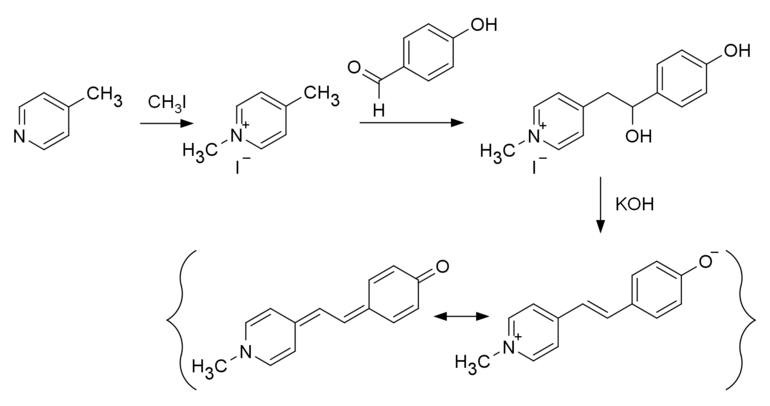Brooker's merocyanine
 | |
| Names | |
|---|---|
| IUPAC name
1-methyl-4-[(oxocyclohexadienylidene)ethylidene]-1,4-dihydropyridine | |
| Identifiers | |
3D model (JSmol) |
|
| ChemSpider | |
PubChem CID |
|
| |
| |
| Properties | |
| C14H13NO | |
| Molar mass | 211.26 g/mol |
| Appearance | Red crystals |
| Melting point | 220 °C (428 °F; 493 K) (decomposes) |
Except where otherwise noted, data are given for materials in their standard state (at 25 °C [77 °F], 100 kPa). | |
| Infobox references | |
Brooker's merocyanine (1-methyl-4-[(oxocyclohexadienylidene)ethylidene]-1,4-dihydropyridine, MOED)[1] is an organic dye belonging to the class of merocyanines.
MOED is notable for its solvatochromic properties, meaning it changes color depending on the solvent in which it is dissolved.
As shown in the structural formula, MOED can exist in two resonance forms: A neutral molecule and a zwitterion. Research indicates that the zwitterion form is most representative when the compound exists in polar solvents such as water, and the neutral form when it exists in nonpolar solvents such as chloroform. [2]
Solvatochromic effects

When MOED is dissolved in various liquids, its colour will vary, depending on the solvent and its polarity. In general, the more polar the solvent, the shorter the wavelengths of the light absorbed will be. When light of a certain colour (wavelength) is absorbed, the solution will appear in the complementary colour of the one absorbed. Therefore, in water, a highly polar solvent, MOED appears yellow (corresponding to absorbed blue light of wavelengths 435-480 nm), but is purple or blue (corresponding to absorbed green to yellow light of wavelengths 560-595 nm) in acetone, a less polar solvent. The effect stems in part from the stabilization of the ground state of the merocyanine molecule in polar solvents, which increases the energy gap between the ground state and excited states, which corresponds to shorter wavelengths (increased energy) of the absorbed light.
Uses
Because of its solvatochromic properties MOED, and solvatochromic dyes in general, are useful as solvent polarity indicators, and for creating solutions that absorb light at a specific frequency. Additional potential areas of use include pH sensors and transition metal cation indicators. Research into merocyanine dyes is ongoing.[3]
Synthesis
Brooker's merocyanine can be prepared beginning with the methylation of 4-methylpyridine to produce 1,4-dimethylpyridinium iodide. Base catalyzed reaction with 4-hydroxybenzaldehyde and subsequent intramolecular dehydration provides Brooker's merocyanine.
 Synthesis of Brooker's merocyanine from 4-methylpyridine, methyl iodide, and 4-hydroxybenzaldehyde. Step 2 is catalyzed by weak base.
Synthesis of Brooker's merocyanine from 4-methylpyridine, methyl iodide, and 4-hydroxybenzaldehyde. Step 2 is catalyzed by weak base.
Notes
- ↑ L.G.S. Brooker, G.H. Keyes, R.H. Sprague, R.H. VanDyke, E. VanLare, G. VanZandt, and F.L. White: "Studies in the Cyanine Dye Series. XI. The Merocyanines", Journal of the American Chemical Society, Volume 74. Number 11., November 1951, p. 5350 link
- ↑ "Fundamental Studies on Brooker’s Merocyanine", Morley et al., J. Am. Chem. Soc., 1997, 119 (42), 10192-10202 • doi:10.1021/ja971477m
- ↑ Valerii Z. Shirinian and Alexey A. Shimkin: "Merocyanines: Synthesis and Application", in Topics in Heterocyclic Chemistry, Springer, 2008
References
- M J Minch and S Sadiq Shah: "Spectroscopic studies of hydrophobic association. Merocyanine dyes in cationic and anionic micelles". Journal of Organic Chemistry, 44:3252, 1979.
- Amaresh Mishra, et al.: "Cyanines during the 1990s: A Review", Chemical Reviews, 2000, 100 (6), 1973-2012 • doi:10.1021/cr990402t
- Christian Reichardt: "Solvatochromic Dyes as Solvent Polarity Indicators", Chem. Rev., 1994, 94 (8), 2319-2358 • doi:10.1021/cr00032a005
- S. J. Davidson2 and W. P. Jencks: "The Effect of Concentrated Salt Solutions on a Merocyanine Dye, a Vinylogous Amide", Journal of the American Chemical Society,1969, 91 (2), 225-234 • doi:10.1021/ja01030a001
- Brooker, Keyes, et al.: "Studies in the Cyanine Dye Series. XI. The Merocyanines", J. Am. Chem. Soc., 1951, 73 (11), 5326-5332 • doi:10.1021/ja01155a095
- Brooker, Keyes, et al.: "Color and Constitution. XI.1 Anhydronium Bases of p-Hydroxystyryl Dyes as Solvent Polarity Indicators", J. Am. Chem. Soc., 1951, 73 (11), 5350-5356 • doi:10.1021/ja01155a097
- Mohamed K. Awad and Shakir T. Abdel-Halim: "Mechanism of Water Attacking on Brooker’s Merocyanine Dye and Its Effect on the Molecular and Electronic Structures: Theoretical Study", Bull. Chem. Soc. Jpn. Vol. 79, No. 6, 838–844 (2006)
- H.S. Freeman and S.A. McIntosh, "Some Interesting Substituent Effects in Merocyanine Dyes", Educ. in Chem., 27(3) 79(1990).